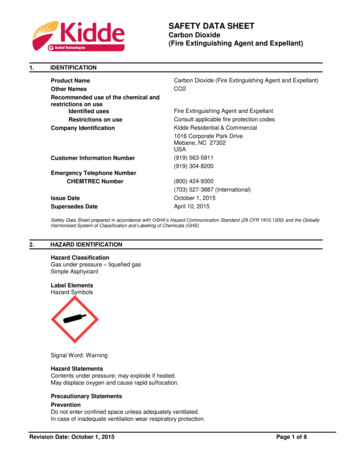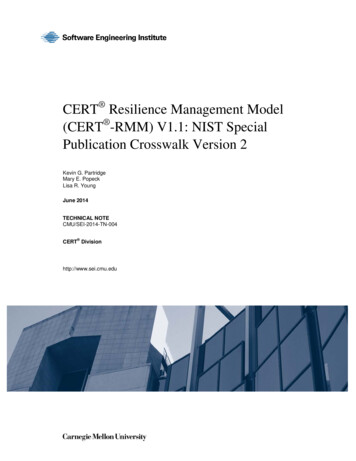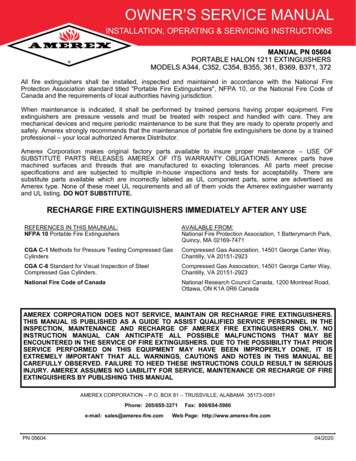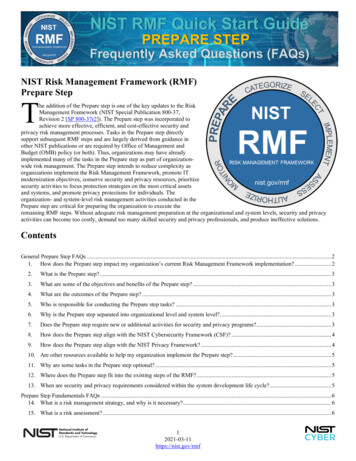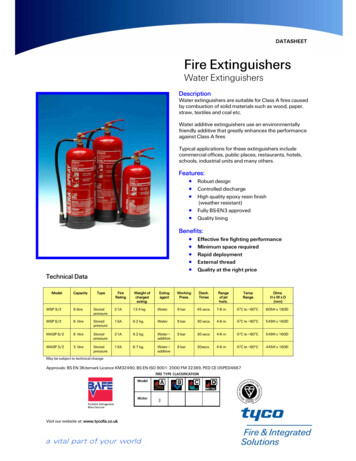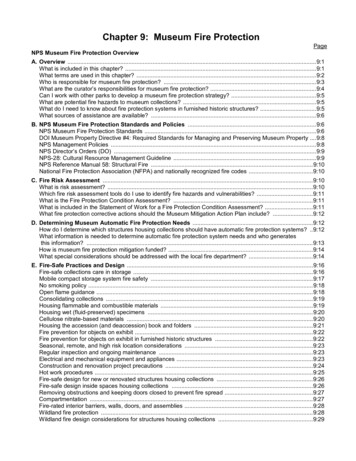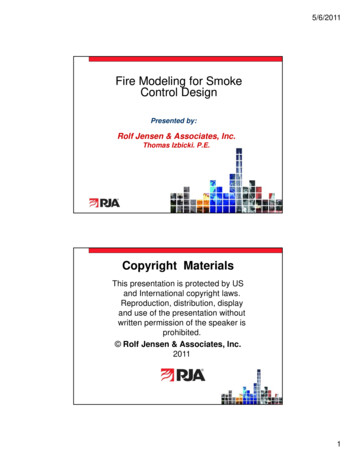
Transcription
UNITED STATES DEPARTMENT OF COMMERCENATIONAL BUREAU OF STANDARDS.E. U. Charles Sawyer, SecretaryCondon, DirectorBulb-TypeFire Tests ofCarbon-Tetrachloride Fire Extinguishersby O.J.HodgeNational Bureau of Standards Miscellaneous Publication 197IssuedForsalebythe Superintendent ofDocuments, U.S.May8,1951Government PrintingOffice,Washington25,D. C.:Price 10 cents
PrefaceThe National Bureau of Standards has received numerous inquiries relativeto the effectiveness of small bulb-type carbon-tetrachloride fire extinguishers,not only when used as hand extinguishers for first-aid fire protection but alsowhen employed for the automatic protection of enclosed spaces.This paper gives the results of some fire tests that the Bureau's Fire Protection Section has made of devices of this sort.The information is intendedto assist in the evaluation of fire extinguishing equipment of smaU capacity.E. U. Condon, Director.ii
ContentsPagenPrefaceI. IntroductionII. Description of devices testedIII. Tests of devices as hand extinguishers1Results of tests1122.Summary and discussion of resultsIV. Tests of devices as automatic extinguishers1. Extinguishers A to F(a) Results of tests(1) First test with two extinguisher units(2) Second test with four extinguisher units3332.(b)2.Summary444of resultsExtinguisher G(a) Results of teststwo extinguisher units on classwith three extinguisher units on(1)First test with(2)Secondtestfires(b)SummaryV. Conclusionsof resultsAfires.class6666B778in
.Fire Tests of Bulb-Type Carbon-TetrachlorideFire ExtinguishersO.J.HodgeResults are given of fire tests on samples of seven different bulb-type carbon-tetrachlorideextinguishers ranging in capacity from 0.44 to 1.75 quarts. Six of the extinguishers wereThe seventh device was tested for autotested both for manual and automatic operation.matic operation only, since it was not designed for manual use.The tests of the devices as automatic extinguishers were conducted in a room withventilation just sufficient to permit the test fires to burn freely until the fuel was consumed,with no extinguishers present.The test results showed that the bulb-type carbon-tetrachloride fire extinguishers, asrepresented by the samples tried, when operated by hand were distinctly less effective thanthe ordinary one-quart carbon-tetrachloride pump-gun extinguisher, and when employed asautomatic devices were not effective for the protection of the enclosed space. The sevendevices were tested in the number recommended by the manufacturer and six of them werealso tried in double that number.fireI.Introductiontion onlyfrom theThe National Bureauof Standards has conducted several series of tests to determine the(effectiveness of bulb-type fire extinguishers usingjcarbon tetrachloride as the extinguishing agent. The devices investigated included seven different[models, of which six were designed both for handThe seventh extin and automatic operation.guisher was designed for automatic operationonly.The capacities of the extinguishers rangedfrom 0.44 qt (14 fl oz) to 1.75 qt (56 fl oz).II.Iiwas mounted in a bracket to be hungand was especially designed toceilingdischarge 1.75 qt of extinguishing liquid in theof a spray when the temperature of the airsurrounding the device rose above a predeterminedformvalue.Theincluded in the tests areto G, as listed in table 1In all the tests of the devices designated as automatic extinguishers, the units were installed inextinguishersdesignatedbyAaccordance with the manufacturer's instructions.Description of Devices TestedThe six extinguishers designed for both handand automatic operation consisted essentially of aglass flask or bottle containing from 0.44 to 1.00The extinguishersqt of extinguishing liquid.were mounted in a bracket intended to be hungon the wall or, in some cases, from the ceiling.The general character of the extinguishers is shownin figure 1.The sketches are diagrammatic toillustrate two styles of the devices tested, but donot represent them, exactly.For hand operation, the bottle was intended tobe removed from its bracket and the contentsapplied either by throwing the extinguisher intothe fire forcibly enough to break the bottle or bysprinkling the liquid from the bottle on the fire.For automatic operation, each of the six extinguishers was equipped with a thermostaticdevice intended to release the liquid when thetemperature at the extinguisher reached a predetermined value. The thermostatic device wasattached to the bracket or to the extinguisheritself.Two methods of release were included.One permitted the bottle to fall to the floor andbreak, thus discharging the liquid; the other permitted the liquid to sprinkle from the bottle whilestill held in the bracket.The extinguisher intended for automatic opera92S971— 51(2IFig ure1.ers tested.General character of two styles of the extinguish-A, Drop-on-floor type; B, Spring-operated type.1
.Table1.Extinguishers included in thetestsItTemperature atExtinguisherdesignationAmountofMethod of operationhand extinguisherextinguishing liquidasusedwhich device wasintended tooperatewhen usedas automaticextinguishersquare2withqt of gasoline as fuel.be extinguished with a 1-qt pump gun by the use ofonly about one-half of its charge. In the testson the 3- by 3-ft and 2- by 2-ft-area fires, only oneunit was used in each trial.Of these two fires,that on the 2-ft-sq area was the most difficult toextinguish because of the greater depth of gaso2-ft(4 ftwas found by)1test that this fire 59.75.841.001.75 ThrowingSprinklingdoThnwirteor sprinklingSnrinklingThrowing.or sprinklingTests of Devices asguishersHandF150160160158160158170Extin-By reason of the nature of the extinguishingliquid employed, devices of the carbon-tetrachloride type when used as hand extinguishers are notsuitable for fires in ordinary freely burning materials such as wood, trash, and the like ("classA" fires). The liquid is, however, effective forfires in highly flammable materials such as gasoline, oil,and the like(classResults of Tests1.The results of the tests of the devices asextinguishers are given in table 2.Table2.Results oftests of the devicesashandhand extinguishersExtinguisherWasAreaB fires)As the devices tested employed an effectiveextinguishing medium, the question to be answeredin the tests was whether they made available (forclass B fires) a sufficient quantity of the liquid andapplied it in a sufficiently effective manner to beTherefore, to evaluate theof practical value.effectiveness of the devices, they were tested incomparison with the 1-qt carbon-tetrachloriclepump-gun extinguisher, which is the smallestextinguisher of that type generally recognized asacceptable for first-aid fire protection.For testing extinguishers of the 1-qt carbontetrachloride pump-gun type, certain "standard"Among these firestest fires are commonly used.are (1) a fire of 1 gal of gasoline on a 4- b} 8-ftfloor area, and (2) a fire of }i gal of gasoline on aFor the purposes of com4- by 4-ft floor area.parative tests of the bulb-type extinguishers withthe 1-qt pump-gun extinguisher, the second, orsmaller, of the two test fires was selected first.This fire can easily be extinguished by the 1-qtpump gun. When (as indicated in the test resultsgiven below) it was found that none of the bulbtype extinguishers could extinguish this fire whenonly one unit was used, trials were made in whicha number of units were applied in succession.Further trials were then made in which the area2of the test fire was reduced from 4 by 4 ft (16 ft )2to 3 by 3 ft (9 ft ), and the quantity of gasolinefrom }o gal to 1 qt. It was found by test that thisfire could be extinguished with a 1-qt pump gunby the use of less than one-half of its charge.Finally, trials were made in which the areaof the original test fire was reduced to a 2- by2The tests were conducted indoors in the Bureau'spanel-furnace test building, in a room approximately 84 ft long by 36 ft wide by 30 ft high.The gasoline was confined to the specified areaon the concrete floor of the room by an edgingconstructed of asbestos dft234564X44X44X44X44X44X4extin-of unitsguished?usedTest1of oNoNoNoThrowingSprinkling.dododoThrowing.Test .75.75.841.00Sprinkling.DDEF5342334.do. do-.-do.do.Throwing—NoYesYesYesYesYesNoTest doTest .Sprinklingdo.do.do.dodo11--111-lNoNoNoNoNoNoOn account of its similarity in design to another extinguisher of largercapacity (extinguisher E), extinguisher B was tried only in the first test onthe 4- by 4-ft-area fire.2 Due to the negative results obtained in the previous trials of the deviceswhich were applied as hand grenades, extinguishers A and F were not tried inthe tests on the 3- bv 3-ft and 2- by 2-ft-area fires.1P
2.The'ISummary andDiscussion of Resultstests discussed in thispaper showed thatthe bulb-type devices when used as hand extinguishers were less effective than the 1-qt pumpgun carbon-tetrachloride extinguisher. In thefirst place, the capacity of the devices was, ingeneral, too small to be practically effective and,in the second place, the manner in which theextinguishing liquid was applied made the devicesless effective than the pump-gun extinguisher forthe same volume of liquid used.The first test showed that none of the devicesput out a relatively simple test fire that the 1-qtpump guncan usually extinguisheasily.Theshowed that to put out this test fire,more (in most cases much more) extinguishingliquid was required.The third and fourth testsshowed that even with test fires reduced in extentand severity to a point where they could be extinguished easily by not more than one-half of thesecondtestcharge of a 1-qt pump-gun extinguisher, thedevices did not put out the test fires except inthe case of one of the units in one of three trials.With the bulb-type extinguishers, the liquid isnot as thoroughly broken up and as readily vaporized as it is with the pump-gun extinguisher, fromwhich the liquid is forcibly projected in a relatively compact stream that changes to a fine spraywhen it strikes objects in the fire. Furthermore,when the liquid is applied by sprinkling from, acontainer, it cannot be as effectively directed as itcan be with the pump gun and, apparently, a considerable portion of the liquid serves to dilute theburning gasoline rather than to cause the formation of a smothering gas blanket.In the trials in which the test fire was notextinguished, the flames were somewhat diminished during the application of the liquid, but thefuel continued to burn with the production ofdense, acrid fumes in great volume.The testswere made in a room with a total volume ofa test space of 2,000 ft. 3 This enclosure containeda single window 3 ft 4 in. wide by 4 ft 10 in. high,with the bottom 3 ft from the floor. It was provided with a fireproof shutter, pivoted horizontallyat the center, which was so arranged that it couldbe set at any given inclination to give the desiredventilation.A tightly fitting door was constructed in the partition to give access to thetest space.This door was kept closed when thetests were in progress.The space in the buildingoutside of the test space contained three wndows,each 3 ft 4 in. by 4 ft 10 in. and one door, all ofwhich were kept open during the tests.During each test, the temperature of the airsurrounding the extinguishers, as well as the temperature at various other points in the test space,was measured with thermocouples. The progressof the test fires was observed by temperaturemeasurements taken at various points in the pathsof the flames.fullapproximately 90,000 ft 3When 1 qt of extinguishing liquid was applied in the manner described above, it was found that shortly afterwardthe fumes became so irritating that the operatorwas driven from the room, and they became soopaque that it was impossible to distinguish objectsat distances greater than 3 or 4 ft.IV. Tests of Devices asAutomaticExtinguishersThe tests of the devices when used as automaticextinguishers were conducted in one of the Bureau's fire-test buildings that contained a singleroom 29 ft long by 15 ft 3 in. wide by 10 ft 1 in.high. The walls were of brick and the floor andceiling, concrete.fireproof partition was erectedacross the building 13 ft from one- end to provideA1.ExtinguishersAtoFAccording to the claims made forAfireextin-F whenpresented for the tests, thetheory of operation was that should a fire occurin the protected space the temperature would riseand the release mechanism would cause the dischargeof the carbon tetrachloride, whereupon the liquidwould vaporize and be carried by the convectioncurrents over the burning area to smother the firewith an oxygen-excluding blanket. According tothis theory, these devices were intended to placea smothering gas blanket locally over a small areaof burning fuel and not to provide vapor sufficientto dilute the atmosphere of the protected space toa point where combustion could no longer be posThissible because of the low oxygen content.theory excluded the use of the devices for fires inordinary combustible materials for which carbontetrachloride when locally applied is not consideredsuitable, and the fires used in the tests were, therefore, confined to fires of flammable liquids (class Bguisherstofires).Because of the danger involved in the handlingof gasoline in a small room, oil rather than gasolinewas used for the fuel. The oil was a mixture oftwo parts of light engine oil with one part of kerosine.The fuel was contained in a pan located onTheFires of two sizes were used.the floor.larger of the two consisted of 2 gal of burning fuelFor the secondin a pan 3 ft sq having 6-in. sides.fire, }i gal of fuel was used in a pan 2 ft sq having1-in. sides.The number of extinguisher units recommendedby the makers was one for each 1,000 ft3 of spaceAccordingly, trials were first madeprotected.with two units in the 2,000-ft test space. Another series of trials was then made, in which thenumber of units was doubled33
Results of Tests(a)ExFirst test with two extinguisher units.was chosen for this test. As showntinguisherin table 1, this extinguisher had a capacity intermediate between that of the smallest and theto F.Inlargest extinguishers in the gioupeach trial, the two units were mounted 5}i ft abovethe floor on the vertical center lines of the twoend walls of the test space.In every trial, the test fire pan was on the floor.Trials were first made with the pan at the centerof the test space (location a), then with the pannext to one of the 13-ft walls directly under oneof the two extinguishers (location b), and finallywith the pan in a corner of the test space (locationThe three locations of the pan are shown inc).Location b is also indicated in figure 3.figure 2.(1)CAWINDOWtest were the following: Extinguisher A, one ofthe two extinguishers having the smallest capacity(0.44 qt) of those tested; extinguisher F, havingthe largest capacity (1.00 qt) and in one trial,extinguisher E, having an intermediate capacityL 1;i,(0.84 qt).TEST- FIREPANINLOCATION CEXTINGUISHERJ!IEXTINGUISHERINTEST- FIREPANLOCATION aTEST- FIREINPANLOCATION bCLOSED DOOR,-2-11TwoAto Ffirst series of trials of devicesas automatic extinguishers.units used; 3-foot-square test-fire pan in trials 1 to 3; 2-foot-square panFlGTJRE2.Plan forin trials 4 to 8.During these trials, the shutter was tilted sothat the ventilation through the window, bothabove and below the shutter axis, was just enoughto permit the fuel in the test space to burn freely.The results of the test are given in table 3.extinguisher units.(2) Second test with jourThe second test, in which four rather than twoextinguisher units were used in each trial, was madebecause of the negative results shown in the firstThe extinguishers chosen for the secondtest.4FigureThe3.testAtoTrial 5, first series of tests of devicesas automatic extinguishers.pan was located directly beneath one of the extinguisherunits, asshown.F
ITableTestResults of tests of devices3.AFtoas automatic tityAreaLoca-oftiontestofpanfiregal222.do.do - .do.doVlHH.doityunitsunitswhichFuelof .extin-guisher?cabDurationof ionfireput tionNumber 0100100Less14141512min141414110.711.911than 1YesLessthan X3aAadddAEFFSee figure 2 for test 1, and figure 4 for test 2.2 The ambient temperature at 1 extinguisher was 205 to 210 F for \\ i minand at the other extinguisher, 200 to 250 F for 2}i min.3 The ambient temperature at the 4 extinguishers for 10 min during the test1In each trial of the four samples under test, twowere mounted on the 15-ft 3-in. wall and two onthe partition opposite.The extinguishers weremounted at a height of 5}i ft from the floor andwere spaced 3 ft 10 in. from the 13-ft walls, asshownin figure 420.43044 0131514131313131313was 370 to 415 F, 255 to 310 F, 355 to 410 F. and 245 to 285 F, respectively.4The ambient temperature at the 4 extinguishers for 10 min during the testwas 230 to 300 F, 275 to 310 F, 315 to 355 F, and 2o0 to 300 F, respectively.Onaccount of the nature of the results obtainedin the first test, it was not considered necessaryin the second test to include all the test conditionscovered in the first. Therefore, only one of thetwo test fires was used, the fire of 2 gal of oil andkerosine in the 3-ft-sq pan. The trials were madeat location a with the pan on the floor at thecenter of the test space, and at location d, withthe pan on the floor adjacent to one of the 13-ftwalls.During thetrials,the lower half of thewindowin the 15-ft 3-in. wall was sealed off, and the shutter was tilted to leave an opening 40 by 20 in. inAdditional ventilation was prothe upper half.vided for these tests by an opening approximately40 by 20 in. in the fireproof partition opposite.Both openings were above the midheight of thetest space, which was a condition recommendedby some of the makers of the devices tested. Thetotal area of the ventilating openings amounted to4 percent of the wall area above the midplane ofthe enclosed space. Trials with no extinguisherspresent showed that these openings provided justenough ventilation to permit the test fires to burnfreely until the fuel was consumed.The resultsof these trials are given in table 3.Figure4.Plan for secondseries of trials of devicesAtoFas automatic extinguishers.Four units used;3-foot-square test-fire pan.5
Summary(b)of ResultsThe tests of the devices in group A to F whenused as automatic extinguishers were conductedin a room of 2,000-ft 3 capacity in which the ventilation was sufficient to permit the fires to burnThe testsfreely until all the fuel was consumed.showed that when two extinguisher units(ex-tinguisher C) were used the devices were noteffective in extinguishing or checking relativelysimple test fires located on the floor, except whena small fire was located directly under one of theextinguishers so that all its liquid was promptlydischarged into the pan of burning oil. When theunits were doubled in number and located so thatno extinguisher was directly above the test fire,the devices (extinguishers A, E, and F) failed toextinguish or check the fires either when theywere in the center of the room or against the wall.The thermal release mechanisms of some of theunits failed to operate as intended.2.Extinguisher2 in. apart in each layer,Those of each layerwere laid transversely to those of the preceding'layer.A cube was thus formed approximately24 in. on the side, with air channels to affordready combustion. The cube was built onsupports Iji ft from the floor and was ignitedby K gal of gasoline in a pan placed 1 ft below11the cube.Theresults of the test are given intable 4.GExtinguisher G was in the nature of an installedsystem that operated on the principle of dilutingthe atmosphere of the entire protected space to apoint where combustion would no longer beThepossible because of the low oxygen content.claims for this device did not exclude fires inordinary freely burning materials, as was the caseHence,for the extinguishers in group A to F.in the tests of this extinguisher, trials were madeboth on fires of freely burning material (classFigure5.fires offlammable liquid(classBautomatic extinguishertrials ofwoodGon'Gonffire.Two extinguisherAandfires)Plan forunits used.fires).The ventilating openings in the test space werethe two 40- by 20-in. windows used in the secondto F.series of trials of extinguishersThe number of extinguisher units specified bythe maker for extinguishing fires in ordinary freelyburning materials was one for every 1,000 ft 3of space protected and for putting out fires ingasoline, oil, and like materials, one for everyAccordingly, in the trials on the wood750 ft 3fires, two extinguishers were used and in the trialson the oil fires, three extinguishers. The unitswere suspended from the ceiling on the longitudinalcenter line of the test room and were equallyspaced, as shown in figures 5 and 6.A.(a)Results of Testswith two extinguisher units onFor the class A fires, one of the woodfires frequently employed as "standard" for the2%-gal soda-and-acid hand extinguisher was used.(1)classFirsttestA fires.The fuel for this fire consisted of 78 pine sticks2 by 2 by 24 in. long.The sticks were arrangedin 13 layers.They were laid parallel and aboutFigure6.Plan fortrials ofoil fireonautomatic extinguishernfloor.Three extinguisher units used, 3-foot-squaretest-firepan.t
Table4.TestResults oftests ofGautomatic extinguisherAVasAreaof testpanLocationof firegalWood 3.adodOil3X33X33X323-doand wood3used3.-of unitsextin-whichguishers?Fuel con-sumedIduration2of o10040100See figure 5 for test 1 and figures 6 and 7 for test 2.fires, this was the time when the stack collapsed.See description in text.One unit failed to operate, although the ambient temperature at the extinguisher was about 400 F for 8 min.One unit discharged cnly one-half its contents, although the ambient temperature at the extinguisher was 390 to 480 1of fire,operated22TESTOil.of unitsby theft121Numberof oilTEST231NumberDurationfireput city13«423»132222For the wood23466Durationof oil fire.WoodFforover 2 min.continued to burn. 8 with three extinguisher units onFor the class B fires, 2 or 3 gal of\class B fires.the mixture of two parts light engine oil and onepart kerosine were used in the 3-ft-sq pan havingl(5-in. sides.The results of these trials are givenin table 4.The third trial in the second test was madebecause it appeared probable that, since the firein the previous trial was located directly underone of the extinguishers, the extinguishment ofthe fire had been accomplished by a local gasblanket rather than by dilution of the wholeatmosphere of the enclosed space. Hence, in thethird trial, the same test fire was used, but thepan was placed beneath a wooden bench and about18 in. off the floor, as shown in figure 7.(2)Secondtest(b)Summary EXTINGUISHER ',4 FTSQUARE BENCH TOPTTEST-FIREPANIN LOCATION fELEVATIONof ResultsG were conducted in2,000-ft3 room used for similar tests ofsmaller extinguishers. As in those trials,sufficient ventilation was provided to permit thefires to burn freely so that they would not extinguish themselves.As indicated in table 4, in both of the trials withfire) thea fire of freely burning material (classextinguisher, when one unit was used for each1,000 ft3 of space, failed either to extinguish orThethethetests of extinguishersameAcheck the fire.In the tests with the oil fires (class B fires), inwhich one unit was used for each 667 ft3 theextinguisher failed to put out or check the test,firesintwoof the trialsand extinguished thefireIn that trial, the fire was placeddirectly beneath one of the units.It appeared probable that, under the conditionsof the third trial, the fire was not extinguished bydilution of the atmosphere of the enclosed spaceinonebutbytrial.a local blanketing effect.PLANFigure7.Plan andtinguisher Gwood bench.elevation for trial of automatic exon oil fire in S-foot-square pan shielded byThree extinguisher units used.7
in the number recommended by the manufacturer,and six of them were also tried in double thatV. Conclusionsnumber. 2The tests indicated clearly that when handoperated the bulb-type carbon-tetrachloride extinguisher, as represented by the samples tried,was distinctly less effective than the 1-qt pumpgun extinguisher, the smallest generally consideredacceptable, principally by reason of the mannerof hand extinguishers recommended for use on fires in flamfires) are described in the Manual of Fire-Loss Preven(classHandbook of Fire Protection,tion of the Federal Fire Council and the1BNFPATenth Edition. The Manual may be purchased from the Superintendentof Documents, Government Printing Office, Washington 25, D. C, at 30cents a copy. The Handbook is published by the National Fire ProtectionAssociation, 60 Batterymareh Street, Boston 10, Mass.2 Water-sprinkler systems are commonly employed for the automatic protection of enclosed spaces in which the combustibles are of the usual freelyburning solids. For flammable-liquid fires in enclosed spaces, automaticallyoperated systems employing carbon dioxide or foam are sometimes installedwhich the liquid was applied.devices when employed as automatic extinguishers were not effective in protectingThe seven devices were testedthe enclosed space.1inOther typesmable liquidsThe bulb-typeWashington, Julyo24, 1950.
fire Extinguisher Desig-nation I'upae-ity Methodofoperation Number ofunits used Was fire extin-guished? Test1 ft qt 1 4X4 A 0.44 Throwing No 2 4X4 B i.44 Sprinkling. No 3 4X4 C.59 do No 4 4X4D.75 do No 5 4X4 E.84 do No 6 4X4F 1.00 Throwing. No Test2 1 4X4 A 0.44 Throwing. 5 No 2 4X4 0.59 Sprinkling. 3 Yes 3 4X4 C.59 do 4 Yes
